|
Airplanes and Rockets website
visitor Peter C., of the UK, contacted me about scanning information from a vintage
copy of American Aircraft Modeler magazine. Peter requested the 3-view
drawing of the Pfalz D.III biplane (by Mr. Björn Karlström) that appeared in the
July 1973 edition. I did him one better by also scanning and OCRing the text of
the accompanying article as well. Author Patricia Groves did a very thorough job
of researching the history of the Pfalz D.III biplane, and included some rarely
seen photos of the various versions. Enjoy.
The Bavarian Woods
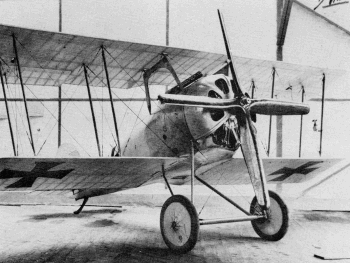
A brand new D.VIII In standard factory finish (aluminum dope).
Type-tested in January 1918, production models carried a 160-h.p. Siemens-Halske,
11-cylinder, geared rotary. The propeller revolved at 900 rpm counter to the revolving
(also at 900 rpm) crankcase and cylinders.
A brief history of Pfalz. / by Patricia T. Groves
When the Imperial German Military Air Service of the German Army struggled underway
in October 1912, not only was it blessed with the usual general staff firmly entrenched
in 19th Century military tradition, it had Bavaria, too.
In 1871, after negotiating a generous political and economic settlement to bolster
its basically forest and farmland economy, Bavaria entered the German Empire. Also
retaining more sovereign rights than any of the other member states, the characteristically
independent-minded Bavarians kept control over their own railway, telegraph and
postal systems, a separate diplomatic service, as well as their own military administration.
Thus, whenever Bavarian soldiers were involved, Germany heard a lot of heavy breathing
in the background.
Shortly after the German air arm came into being, the Bavarian Air Ministry-endeavoring
to insure control over the equipment its flying service would use-turned to its
own industry. And, in a section of Bavaria known as The Palatinate (in German,
die pfalz1), it found the Everbusch brothers striving to get
into aeronautics.
On slim financial footing Alfred, Ernst and Walter Everbusch had hoped to acquire
license for production of the Albatros. When these negotiations fell through, the
Bavarian government stepped in and helped secure production rights from the Otto
airplane works for their pusher biplane. With this initial security plus additional
guidance from Gustav Otto, the Pfalz Flugzeug-Werke G.m.b.H. opened its factory
at Speyer am Rhein in July 19132.
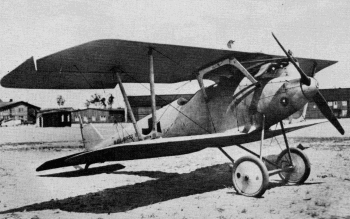
Phalz D.IIIa (Serial 6033/17). The vertical fins of the Phalz
III and IIIa aircraft to the fuselage. An inverted airfoil on the tailplane gave
more rapid dive recovery (Builder's Note: All struts carry aircraft serial number.)
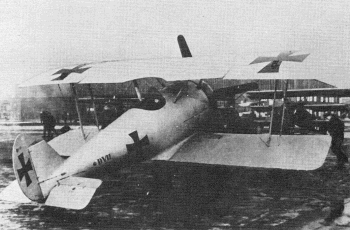
Predecessor to the D.VIII was this single bay strut D.VII entered
in the January 1918 Fighter Competitions. (Builder's Note: Cross Patee began to
phase out in late March 1918.)
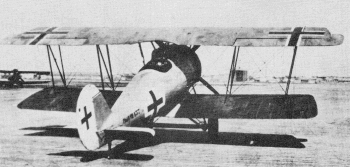
Pfalz D.VIII (Serial 157/18). N-struts and balanced ailerons
distinguish this modified C.VIII. (Builders Note: Length of the vertical bars on
the Greek Cross paint scheme dates this photo as after May 31, 1918.)
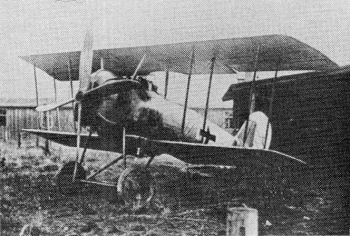
A production D.VIII abandoned by the Germans. Reportedly "pleasant
to fly," double-bay construction gave greater rigidity.
But pusher aircraft had a limited future, and since the company wasn't ready
to produce its own design, Alfred Everbusch looked around for a more promising airplane.
In early 1914 he acquired license from Morane-Saulnier of Frarice to produce their
Type H monoplane and Type L parasol. Walter, the youngest of the Everbusch brothers,
then enrolled in Morane-Saulnier's flying school near Paris. After graduating in
July 19 4, e served as a test pilot for Pfalzl 's death in June 1916.
With the onset of WWI in August 1914, German militarists figured that an unprepared
enemy would wrap things up in a hurry, and so
the use of aircraft wasn't seriously considered . But, when the enemy unexpectedly
dug in its heels, the German General Staff was forced to take another look at its
aviation potential. At this time there were 30 German air units plus four Bavarian
- all of which looked better on paper3. In reality, they were under strength
and poorly equipped, having a few airplanes that could be considered "combat ready."
By this time the Pfalz company had built three of the Morane monoplanes, three
of the parasols and were nearly ready to deliver three Otto pushers to Bavarian
air units. Although still not ready to produce their own design, they were acquiring
a cram course in aircraft construction and beginning timid innovations on the Morane
designs.
In the early months of the war they produced the Pfalz A.I and A.II aircraft
which differed little from the original Morane Type L. Going into limited production
with the A.I (80 hp Oberursel engine) and A.II (100 hp Oberursel), the company expanded
and opened a flying school using some of these machines to train Bavarian pilots,
while others of the aircraft went into front-line service on reconnaissance or escort
duty4.
Then, taking the Morane Type Hand modifying it to a shoulder-wing mono-plane,
the Pfalz E.I (with Fokker synchronizing gear) became the first of the company's
airplanes to carry a machine gun. In outward appearance its box-like configuration
strongly resembled the Fokker monoplane. However, in contrast to the welded steel
tube Fokker, the Pfalz E had a completely wooden skeleton. About 60 of these aircraft
were followed by a series of variants.
With the production of each airplane, the Pfalz company increasingly injected
its own ideas and construction techniques. Ernst and Walter were giving flight demonstrations
to combat pilots, while, back at the plant, company engineers were improving on
available designs. By April 30, 1916 over 100 of their aircraft were in operational
use. But the end of the 'eindecker' contract was in sight.
Since August 1914 the exigencies, the attritions, the point-counterpoint needs
of war forced design engineers to think in terms other than aerodynamic esthetics
and purity. By the end of 1916 (with the era of powered, manned flight but thirteen
years Old), the immediate need was for engine power and the rugged maneuverability
of the biplane fighter.
One of the greatest influences in aircraft design was the appearance of the Nieuport
17 on the Western Front in March 1916. Produced by the French, British, Belgians
and Italians, the Nieuport enjoyed an Allied exclusivity until its appearance from
the other side of the lines, one day, sporting the Cross Patee. Introduction of
the Siemans-Schukert "variant" acknowledged the universality of the Nieuport design.
In the summer of 1916 the Pfalz company built a biplane whose heritage was strongly
rooted to past company aircraft. Test flown, it was found to be lacking. However,
a few months later the factory obtained license and contract to build the L.F.G.
Roland D.1 biplane.
Whereas previous Pfalz aircraft had typical flat-sided, fabric-covered fuselages,
the Roland design (showing Albatros lineage) featured a smoothly rounded contour.
This contract would initiate the classic shape and construction technique that,
in the future, would identify the Pfalz. The first Roland D.1 (Pfalz) passed its
proving flights in January 1917, and a small production run gave Pfalz engineers
lead time to develop an original design.
By June 1917, after extensive testing at Germany's Adlershof flight test center,
the Pfalz D.III became the company's first real production aircraft. With an oval,
tapering monocoque fuselage giving it a sleek torpedo-like exterior, the Pfalz D.III
was constructed in two halves over molds (like the early Deperdussins). Plywood
bands, 9 cm wide, were laid in opposite directions over a minimum frame. After the
two halves were mated, the whole structure was covered in a thin fabric and doped5.
It was a technique they'd improve on as time went by.
Universally, these early day monocoque constructions, although stronger, were
heavier than conventional aircraft. But, never having been a strong ore-producing
country in the first place, Bavaria hadn't developed a large cadre of metal workers.
Since both the men and materials required for conventional aircraft construction
had to be "imported," when inevitable war time Shortages combined with an unimpressive
priority in the distribution of German goods, the Pfalz company made use of locally
available lumber and developed home-grown talent. Since Pfalz was responsible only
to the Bavarian government, rather than the German Directorate of Aircraft Production,
this gave them greater freedom to operate-which, in turn, was followed by an inherent
parochialism. Nevertheless, in the four years of the company's existence, it became
a full-fledged partner in the Empire's aviation industry.
As the war grew hotter, pilots on either side battled to counter increasingly
sophisticated aerobatics above the war zones, while engineers at home strained to
produce new possibilities in engine and aircraft design. Over the next year, with
the exception of a quick pass at a triplane and a momentary flirtation with a Rumpler
C.IV, Pfalz concentrated on improving its D.III and D.IIIa biplane and getting into
full-scale production.
By November 1917 the company had a design staff of 15 engineers under Chief Engineer
Rudolph Geringer and 11 new fighters were in various stages between drawing board
and maiden flight.6 In the factory, the workers were busily expanding their expertise
in monocoque construction.
When the January 1918 Fighter Biplane Competitions were announced, Pfalz selected
three biplane variants to send to the Adlershof trials: the popular Mercedes-powered
D.IIIa, a graceful D.VI (110-hp Oberursel) and an even structurally stronger Siemens-Halske
powered D.VII. However, losing out to Fokker in these competitions, Pfalz then prepared
to meet the May/June trials head-on.
Entering their D.VIII (in three different engine versions) and a D.XII (two different
engines), the company received a small production order. By August 1918, both the
D.VIII (160-hp Siemens-Halske) and the D.XII (160-hp Mercedes) were in front-line
service. And by now, the Pfalz company had 2,600 employees and was producing close
to 200 aircraft a month.
Working up to the last minute, the final Pfalz single-seat biplane variant (a
D.XV) was tested on 4 November 1918. But, with the Allied armies closing in, the
handwriting was on the wall. Orders soon went out from the German High Command to
destroy all military and industrial records to keep them from falling into Allied
hands. (In 1945 this same order went out again. Fortunately for historians, in both
instances, a little luck and a little fudging kept this from being carried out to
the extreme.)
Since the city of Speyer fell under French occupation (where it remained until
1930), the 5½-year-old Phalz Fleugzeug-Werke produced its last airplane at the peak
of its career. With the signing of the Armistice . and de-mobilization, Phalz airplanes
were among the 15,000 aircraft and 27,000 engines to hit the post-war bonfire. Only
a few known Pfalz D.XIIs are in museum care today
NOTES
1. Pronounced: Pfalts, Fahlz, fallts (or, as a last resort) faults.
2. Pfalz Flugzeug-Werke Gesellschaft mit beschrankter Haftung roughly translates
to Pfalz Aircraft, Limited.
3. Peter Gray & Owen Thetford, German Aircraft of the First World War
(New York: Doubleday & Company, Inc., 1970). page ix.
4. Peter M. Grosz and Egon Kruger, PFALZ-The First Detailed Story of the Company
and its Famous Planes (West Roxbury, Mass.: World War I Aero
Publishers, Inc., 1964) page 3.
5. Henry Woodhouse, Textbook of Applied Aeronautic Engineering
(London: T. Werner Laurie, Ltd., ca 1919), page 21l.
6. Peter M. Grosz, The Pfalz D.XIl (England: Profile Publications, Ltd., Number
199), page 3.
Note to the Potential Builder: All the above contain a good supply of black and
white photos for construction data, notes on the flying qualities of the aircraft,
etc. See also Jane's 1919 for construction drawings and the Kenneth Munson books
for color information.
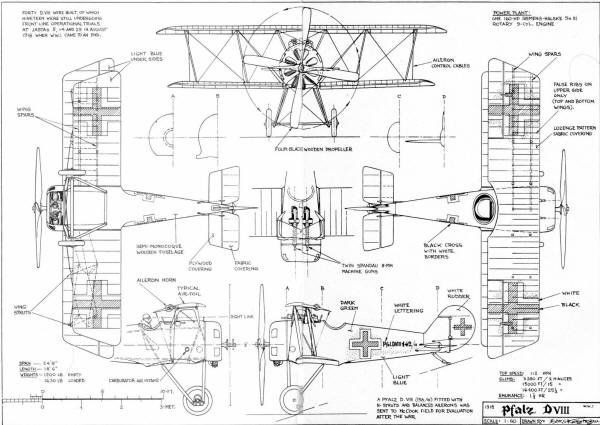
<click for larger version>
The discontinuity in the
middle is due to the page wrapping into the stapled fold area.
Notice:
The AMA Plans Service offers a
full-size version of many of the plans show here at a very reasonable cost. They
will scale the plans any size for you. It is always best to buy printed plans because
my scanner versions often have distortions that can cause parts to fit poorly. Purchasing
plans also help to support the operation of the
Academy of Model Aeronautics - the #1
advocate for model aviation throughout the world. If the AMA no longer has this
plan on file, I will be glad to send you my higher resolution version.
Try my Scale Calculator for
Model Airplane Plans.
Björn Karlström Drawings:
Posted September 22, 2023
(updated from original
post on 10/31/2010)
|